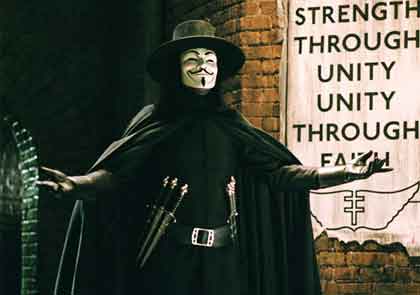« The World’s Fastest Indian (2005) – Movie Review | Home | Thank You for Smoking (2005) – Movie Review »
V for Vendetta (2006) – Movie Review
By Robert L. Jones | March 24, 2006

Hugo Weaving is Snidely Whiplash on a mission in "'V' for Vendetta"
V for Vapid
[xrr rating=2/5]
V for Vendetta. Starring Natalie Portman, Hugo Weaving, Stephen Rea, Stephen Fry, and John Hurt. Screenplay by Andy Wachowski and Larry Wachowski. Directed by James McTeigue. Warner Bros., 2005, Color, 132 min. MPAA Rating: R.
V for Vendetta, the latest installment of the Wachowski brothers’s downward slide into formulaic banality. Directed by James McTeigue, the veteran first assistant director of such fare as Star Wars Episode II: Attack of the Clones and the Matrix trilogy, V is his first directing effort in which nobody but himself can be blamed for monumental ineptness.
Upon its release, V for Vendetta sparked a lot of debate among libertarians for its anarchistic and nihilistic themes, and from that vantage point I was prepared to write this review. Easier said than done. After viewing nearly all four hours of this CGI special effects extravaganza (during which, inexplicably, the hands on my watch moved only two hours and twelve minutes), I scarcely found any dialogue coherent enough to be debated.
Set in the England of the future, V for Vendetta centers around its “hero,” V, played by Hugo Weaving. V is a refined man of culture (after all, who doesn’t enjoy hearing Julie London sing “Cry Me a River”?), who surrounds himself with now-banned books. For you see, the great Fortress has been taken over by “Norsefire,” a fascist theocracy. Its leader, Chancellor Adam Sutler, is a neo-conservative turned Big Brother, played by John Hurt. Just so the subtle novelty of a fuming and spitting despot who governs by Jumbotron isn’t lost on the viewer, the makeup people made certain to give Hurt a shortish-cropped mustache and a slicked-back shock of hair reminiscent of a certain Austrian corporal we all know and love.
Against this repressive backdrop, V nurses a four-hundred-year-old chip on his shoulder about the hanging of Guy Fawkes, who in 1605 tried to blow up the British Parliament. V also has a laundry list of personal grudges: he survived a secret government biological warfare experiment gone awry, as well as burns over one hundred percent of his body.
All of this is meant to guarantee the viewer’s sympathy for V’s sociopathic killing spree as a knife-wielding assassin and mad bomber. After curfew, he prowls London’s streets, avenging Norsefire’s innocent victims. He hides behind a plaster Guy Fawkes mask, which appears rather stiff, though not as stiff as Weaving’s acting.
V happens upon our damsel-in-distress, Evey Hammond, played by the waifish Natalie Portman, whom he rescues from a back-alley rape at the hands of the curfew police, in a deftly-choreographed, computer-generated bloodletting by stainless-steel daggers that produce the requisite “swoosh” and “chunk” sound effects. V sure moves pretty fast and furious for someone who’s suffered one-hundred-percent body burns. According to the actuarial tables, he shouldn’t be moving at all; but that’s a moot point.
After dispensing with the goon squad, V introduces himself to Evey by way of an alliterative soliloquy containing forty-seven words beginning with the letter “V.” It’s meant to be charming and chivalrous, but comes off more like Snidely Whiplash doing a Jesse Jackson impression. V then asks Evey to accompany him for a night on the town, whereupon he blows up that citadel of British jurisprudence, the Old Bailey. Talk about fireworks on a first date!
The next day, the government takes credit for his dynamiting job, claiming that Old Bailey was condemned as unsafe. Unfortunately, another side effect that V suffered in prison was an abiding and strident narcissism; so he takes over television broadcast studios to inform Londoners that he blew up Old Bailey, and that in one year—on the day Guy Fawkes burns in effigy—he will level Parliament. Through another subtle plot twist—Evey just happens to work as a gofer at the TV studio (surprise!)—V manages to sweep her up as his innocent accomplice. This sets up the tedium that follows, right up to the anticipated anticlimactic climax.
V for Vendetta doesn’t just rip off George Orwell’s 1984; that would imply some sort of thematic unity. Rather, this schizophrenic action pic is a pastiche of at least a dozen works far greater than itself. When not squiring Evey about his secret lair a láThe Phantom of the Opera, V hunts down the bastards responsible for his fate in pale homage to The Count of Monte Cristo, while inciting the people to take back their country in a side plot embarrassingly reminiscent of that other “V”—the 1983 TV mini-series about invading aliens from outer space. The film snitches from cinematic styles and genres, too. There’s even a flashback that seamlessly melds the innocence of awakening lesbian passion with lush Merchant-Ivory “Room With a View” cinematography.
Amidst all the slow-mo slicing and dicing, V is fond of chiding his deserving prey that “ideas do matter.” In his televised appeal to the people, he lays the blame for their loss of liberty where it properly belongs, at their own feet. The film’s tagline—“People should not be afraid of their governments; governments should be afraid of their people”—is a rather Jeffersonian conception that rings with the spirit of limited government.
Yet for all its nods to individual liberty, V for Vendetta fetishizes freedom through its direct advocacy of anarchy. Justifying his annihilation of Parliament, V argues that “the world doesn’t need a building, it needs an idea”—patently ignoring the ideas of common law and representative democracy that very building embodies. Thus we are brought to V’s conclusion: By destroying the betrayed institutions of democracy, somehow, the people will regain their freedom.
This is an obscenity to anyone who remembers his World War II history. From Parliament’s halls, Winston Churchill rallied Britons in their “finest hour” to face down Hitler’s Third Reich on the eve of the Battle of Britain. In their sick revision, however, the Wachowskis defeat the Nazis by leveling Parliament—never mind the fact that the Nazis burned down the Germans’ Reichstag to consolidate power.
Despite V’s pompously vague appeals to the power of ideas, all that viewers are left with is a lot of the moral relativity piffle that leftist professors are so fond of quoting, to the effect that “one man’s terrorist is another man’s freedom fighter.” Substitute the World Trade Center and the Pentagon for Old Bailey and Parliament, and you’ll get the drift of this sickening allegory.
Or, to drive the point closer to home, substitute, in Parliament’s place, Columbine High School in suburban Denver. Before the murderous rage in which Dylan Klebold and Eric Harris massacred twelve schoolmates and a teacher, they produced an amateur video glorifying their school’s wanton and nihilistic destruction.
Thankfully, they took their own sorry lives immediately thereafter. Imagine what cinematic epics Klebold and Harris might have scripted from their prison cells. Their insane musings wouldn’t have looked much different from this nauseating waste of celluloid.
Robert L. Jones is a photojournalist living and working in Minnesota. His work has appeared in Black & White Magazine, Entrepreneur, Hoy! New York, the New York Post, RCA Victor (Japan), Scene in San Antonio, Spirit Magazine (Canada), Top Producer, and the Trenton Times. Mr. Jones is a past entertainment editor of The New Individualist.
Topics: Action Movies, Dramas, Graphic Novel Adaptations, Movie Reviews | Comments Off on V for Vendetta (2006) – Movie Review
